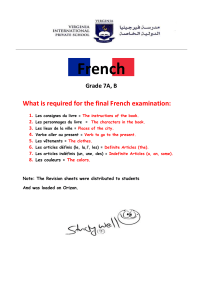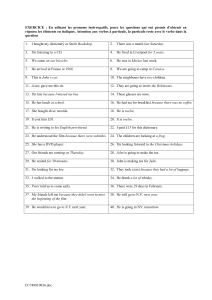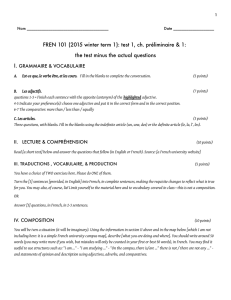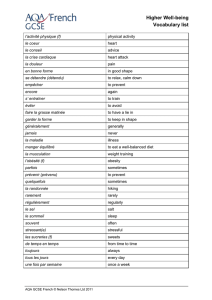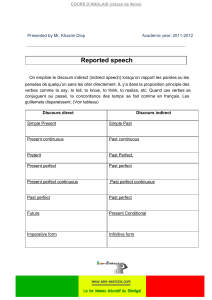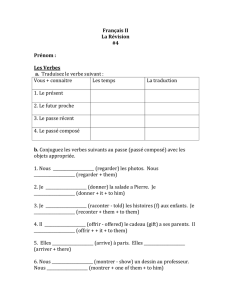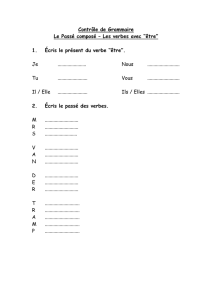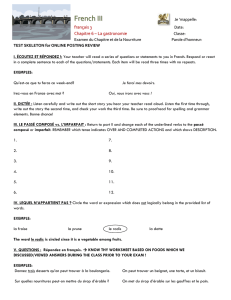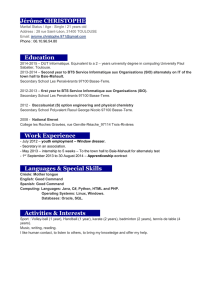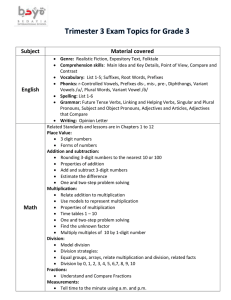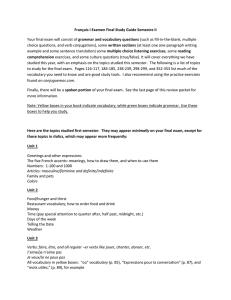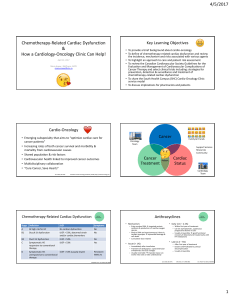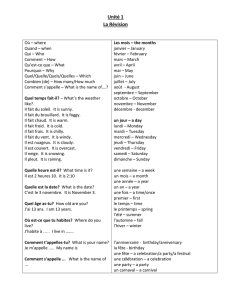Echocardiography findings in HFNEF
publicité
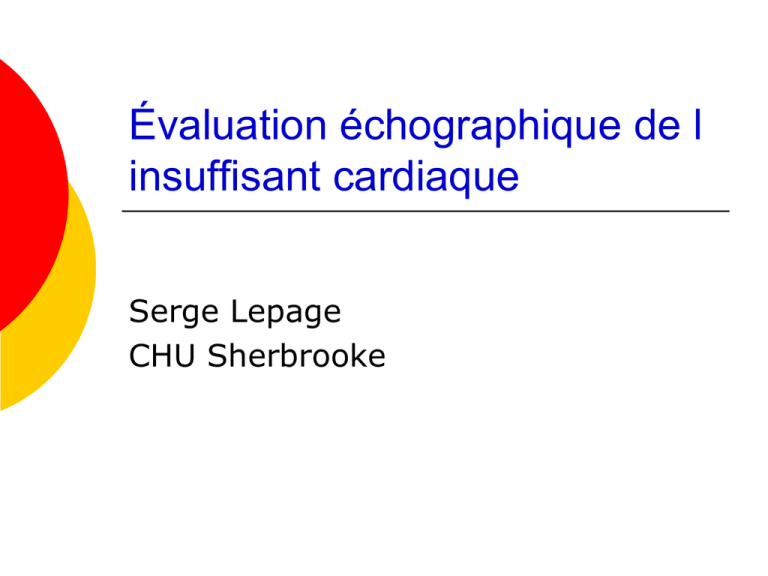
Évaluation échographique de l insuffisant cardiaque Serge Lepage CHU Sherbrooke Evaluation echographique complète • • • • • M-mode, Two-dimensional, Doppler, Color M-mode Myocardial (tissue Doppler) imaging. Evaluation of LV Systolic Function Insuffisance cardiaque Est le résultat de toute anomalie structurelle ou fonctionnelle qui porte atteinte à la capacité du ventricule pour éjecter le sang (insuffisance cardiaque systolique) ou se remplir de sang (insuffisance cardiaque diastolique). Relation pression volume Forces Peut évaluer la morphologie et de la fonction peu cher Pas de rayonnement portable facilement disponible Limitations Trouver une fenêtre acoustique - Espaces intercostaux étroits - Toutes les régions du VG non visualisés chez tous les patients - l'obésité - Intervenir dans le tissu pulmonaire pt chez les MPOC - Malformations musculo-squelettiques par exemple kyposis, déformité thoracique Owan T nejm 2006 Figure 11.1. Diagnostic Criteria: HF with Reduced vs. HF with Preserved EF Clinical evidence of HF: Clear clinical presentation of HF or Framingham or Boston criteria If uncertain: Plasma BNP or chest x-ray or cardiopulmonary exercise testing LVEF < 50% LVEF ≥ 50% Supportive evidence: Supportive evidence: Concentric LVH or remodeling Eccentric LVH or remodeling Left atrial enlargement in absence of AF Exclusions: Non-myocardial disease Adapted from Yturralde FR. Prog Cardiovasc Dis 2005;47:314-19 Echo Doppler or catheter evidence of diastolic dysfunction Exclusions: Non-myocardial disease Lindenfeld J, et al. HFSA 2010 Comprehensive Heart Failure Guideline. J Card Fail 2010;16:e1-e194. Causes dysfonction systolique MCAS Cardiomyopathie dilatée (ICM) 50% idiopathique (au moins 25% familiale) 9% mycoarditis (viral) Cardiopathie ischémique, perpartum, l'hypertension, le VIH, les maladies du tissu conjonctif, de la toxicomanie, de la doxorubicine Hypertension Cardiopathie valvulaire dysfonction diastolique Hypertension Mcas Cardiomyopathie obstructive hypertrophique (CMH) Cardiomyopathie restrictive Implantable Cardioverter-Defibrillators for HF Sustained ventricular tachycardia is associated with sudden cardiac death in HF. About one-third of mortality in HF is due to sudden cardiac death. Patients with ischemic or nonischemic cardiomyopathy, NYHA class II to III HF, and LVEF ≤ 35% have a significant survival benefit from an implantable cardioverterdefibrillator (ICD) for the primary prevention of SCD. Fraction d éjection Dépend de la contractilité, de la précharge et la postcharge, la fréquence cardiaque, la synchronicité des contractions Paramètre global les différences régionales dans la contractilité sont moyenné 17 Cardiac Segments 17 Cardiac Segments Regional function indices WMS Normal =1 Hypo=2 Akinetic=3 Dyskinetic=4 WMSI S WMS/N Evaluation de la fonction VG En présence d'une anomalie de mouvement régional de la paroi toutes les méthodes d analyse seront moins précis, car si la région de mouvement de la paroi anormale est inclus dans les dimensions ou la région de mesures, les volumes seront sur/sous estimés. Evaluation L’ ASE (American Society of Echocardiography) recommande l'utilisation de vues apicales biplan avec une approche de la règle de Simpson modifiée.. Simpson’s Rule – the biplane method of disks LV-ED Volume left ventricle - manual tracings in systole and A4C diastole - area divided into series of disks A2C - volume of each disk ( πr2 * h ) summed = ventricular volume LV-ES Ejection fraction 3. Modified Simpson’s biplane method [2D-Echo] 20 Vol= p/4 S ai bi L i=1 20 [Difference b/w ai & bi should be less than 20%] Most reliable method in case of regional difference in function EF calculated comparable to those measured hemodynamically Limitations Operator dependence - inter/intra observer variability is 10-30% Limited utility - MR high EF but little forward flow - AS low EF but possibly reversible Normal contraction of LV J Am Coll Cardiol Img 2008;1:366 –76 Regional Indices of Left Ventricular Function WMS [wall motion score] Center line chordal shortening Radian change, regional area change Strain rate imaging Torsion imaging Ejection fraction Drawbacks Depends on preload and afterload, as well as HR and synchronicity of contraction. Preload increases [AR,MR, Anemia] EF increases Afterload increases [AS] EF decreases Global parameter, major regional differences in contractility are presented as an average Given EF may have different prognostic importance according to clinical situation eg severe MR Other parameters Myocardial Performance index [TEI index] ICT + IRT ET Measure of both sys & diastolic function Normal <0.4 Strong inverse relationship with EF Independent of ventricular geometry Hellenic J Cardiol 2009; 50: 60-6 Npuvelles méthodes Echo 3d Autimated border detection Strain strain rate Etc Domaines de la recherche Pas encore un standard de soins Thank god Deformation analysis Newer methods of TDI & speckle tracking Analysis of strain, strain rate or torsion Strain- change in distance over time Strain rate- velocity of change over time Deformation analysis Drawbacks Strain not uniform from base to apex & in circumferential plane [anterior & lateral wall higher] Angle dependency Preload dependent Heterogenicity within the same myocardium Patient to patient variability Inter & Intra observer variability APE X 2-D Echo evaluation of LV Function Most common method used is Simpson’s rule Most accurate when LV geometry is normal Correlation coefficients ~ 0.75 compared to RNA, cine angiography & autopsy studies Circulation 1979, 60:760-766; Circulation 1980, 61:1119-112 Limited by reproducibility b/w individual studies Improved by tissue harmonic imaging & contrast use. 3D Echocardiography Direct evaluation of cardiac chamber volumes without the need for geometric modelling and without the detrimental effects of foreshortened views Direct 3D assessment of regional LV wall motion Quantification of systolic asynchrony to guide CRT 3D color Doppler imaging with volumetric quantification of regurgitant lesions , shunts , and cardiac output J Am Coll Cardiol 2006; 48:2053– 69 3D Echocardiography Am J Cardiol 2005;95:809–813 Insuffisance cardiaque diastolique • FE normale avec echo Bi-Di et evidence clinique d une insuffisance cardiaque • Le diagnostic peut être confirmé si l'échocardiographie et l'imagerie par doppler tissulaire du myocarde est anormale. Figure 11.3. Diagnostic Algorithm for HF with Preserved LVEF HF with Preserved LVEF Dilated LV Valvular disease AR, MR Non-dilated LV No valvular dis. High output HF Increased thickness Normal or increased QRS Hypertrophic dis. No aortic valve disease No hypertensive history of PE HCM, Fabry dis. Normal Thickness Low QRS voltage Infiltrative myopathy Aortic valve dis. Aortic stenosis Hypertensive history of PE Hypertensive-HCM Some patients with RV dysfunction have LV dysfunction due to ventricular interaction. Right vent. dysfunction No mitral obstruction Pulmonary hypertension Pericardial dis. Tamponade Constriction Isolated predominant RVMI No pericardial disease Inducible ischemia Intermittent/active ischemia Mitral obstruction MS, atrial myxoma No inducible ischemia, fibrotic, collagenVascular, RCM, cardinoid, diabetes, Radiation or chemotherapy induced heart disease, infiltrative disease, comorbid conditions, reconsider diagnosis of HF Lindenfeld J, et al. HFSA 2010 Comprehensive Heart Failure Guideline. J Card Fail 2010;16:e1-e194. Fonction diastolique vs pression diastolique? • Présentement l insuffisance cardiaque avec fonction systolique préservée représente plus de 50% des patients hospitalisés pour ADHF • L évaluation de la fonction diastolique est donc primordiale • Il faut faire une distinction entre fonction et pression – Analogie entre un pt avec FE 30% ambulatoire et un autre a 35% en OAP – Fonction vs pression (LV/LA EDP) • Présentement l echo est le meilleur outil non invasif pour l évalaluation de la FD Two-dimensional echocardiography • • • • LA size LV thickness LVEF Other structural heart diseases Normal diastolic filling pattern Most LV filling occur in early diastole Longitudinal mitral annular velocity mirrors normal mitral inflow Normal E/e’ in rest and exercise Parameters E/A 0.9-1.5 DT 160-240 ms IVRT 70-90 ms septal e’>10 cm/s E/e’<8 Vp>50 cm/s LAVI-16 to 28 ml/m2 Doppler parameters in different age groups Grade 1 diastolic dysfunction(mild) LV relaxation impaired Slower LV pressure decay Pressure crossover b/w LA and LV occurs late IVRT,DT prolonged Early transmitral gradient is reduced-reduced E vel Adequate diastolic filling period is critical to maintain LV filling without increase in LA pressures Reduced LA emptying in early diastole increases atrial preload-A velocity increases Pulmonary vein diastolic flow velocity parallels mitral E velocitydecreased.Compensatory increase in systolic velocity Pul vein atrial flow reversal usually normal,can increase if atrial compliance decreases or LVEDP higher Septal e’ < 7 cm/s Vp< 50 cm /s Grade 1a diastolic dysfunction Filling pressure is increased (E/e’> 15) with grade 1 mitral inflow pattern Grade 2 –moderate diastolic dysfunction LA pressures are elevated LA-LV pressure gradient restored Pseudonormalised mitral inflow pattern E/A returns to normal,DT normal Differentiation from true normal Septal e’<7 cm/s Valsalva decreases E/A by more than 0.5 Pulmonary vein atrial flow reversal exceeds mitral A duration Vp<45 cm/s Grade 3&4 LV diastolic dysfunction(severe) Restrictive filling Valsalva may reverse restrictive pattern to grade 1 or 2reversible restrictive (grade 3) Even if no change with valsalva reversibility cannot be excluded-filling pressure may be too high to be altered by valsalva Grade 4 dysfunction not used in ASE rec. Early rapid diastolic filling into a less compliant LV cause a rapid increase in early diastolic LV pressure Rapid equalisation produces a shortened DT A velocity and duration shortened as atrial contraction produces rapid rise in LV pressure Systolic forward flow in pulmonary vein reduced due to increased LA pressure E/e’ > 15 Types of Heart Failure Low-Output Heart Failure Systolic Heart Failure: Diastolic Heart Failure: Elevated Left and Right ventricular end-diastolic pressures May have normal LVEF High-Output Heart Failure decreased cardiac output Decreased Left ventricular ejection fraction Seen with peripheral shunting, low-systemic vascular resistance, hyperthryoidism, beri-beri, carcinoid, anemia Often have normal cardiac output Right-Ventricular Failure Seen with pulmonary hypertension, large RV infarctions. The relation between pulmonary artery systolic pressure (PAS) by Doppler versus pressure obtained by right heart catheterization is shown in the left panel (n=63; y=1.1x−0.8). Nagueh S F et al. Circ Cardiovasc Imaging. 2011;4:220-227 Copyright © American Heart Association, Inc. All rights reserved. The relation between pulmonary artery diastolic pressure (PAD) by Doppler versus pressure obtained by right heart catheterization is shown in the left panel (n=25; y=0.62x+12.2). Nagueh S F et al. Circ Cardiovasc Imaging. 2011;4:220-227 Copyright © American Heart Association, Inc. All rights reserved. The relation between average E/e′ ratio and mean PCWP in patients without left bundlebranch block (LBBB) and without cardiac resynchronization therapy (CRT) is shown in the left panel (n=45; y=2.1x−0.03x2−5.5; R2=0.56). Nagueh S F et al. Circ Cardiovasc Imaging. 2011;4:220-227 Copyright © American Heart Association, Inc. All rights reserved. The relation between mean RAP by Doppler echocardiography versus pressure obtained by right heart catheterization is shown in the left panel (n=60; y=0.96x+1.69). Nagueh S F et al. Circ Cardiovasc Imaging. 2011;4:220-227 Copyright © American Heart Association, Inc. All rights reserved. Plot shows the relation between the change in average E/e′ ratio versus the change in mean PCWP in the 12 repeat studies (y=1.2x−0.62). Nagueh S F et al. Circ Cardiovasc Imaging. 2011;4:220-227 Copyright © American Heart Association, Inc. All rights reserved. Fraction – Randazzo, M. Academic Emergency Medicine, 2003 Cross-sectional observational study, convenience sample 115 patients, chest pain (45.1%), congestive heart failure (38.1%), dyspnea (5.7%), and endocarditis (10.6%) Three-hour training session LVEF poor (<30%), moderate (30%-55%), or normal (>55%) Formal echo within four hours interpreted by cardiologist. LVEF correlation 86.1% overall agreement Highest (91%) in normal LVEF category, 70.4% poor LVEF, 47.8% moderate LVEF Imagerie multi modalités Écho plus commun MRI- precision, géometrie complexe JAmColl Cardiol Img 2008;1:652–62 Autres test selon pathologie Conclusion L’ echocardiographie Est important dans la prise en charge du patient Disponible et non effractif Evaluation complete Myocardique Valvulaire Pericardique Cependant il faut percevoir les limitations…


